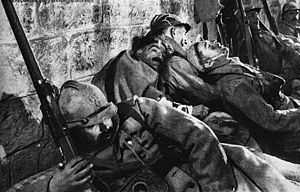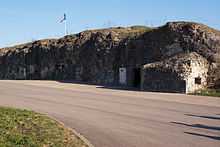Fort Vaux
| Storming of Fort Vaux | |||||||
|---|---|---|---|---|---|---|---|
| Part of the Battle of Verdun, World War I | |||||||
 The exhausted defenders of the fort | |||||||
| |||||||
| Belligerents | |||||||
|
|
| ||||||
| Commanders and leaders | |||||||
|
|
| ||||||
| Strength | |||||||
| 600 | 5,200 | ||||||
| Casualties and losses | |||||||
|
163 dead 191 wounded 246 captured | 2,740 dead and wounded | ||||||


Fort Vaux, located in Vaux-Devant-Damloup, Meuse, France, was built in 1881–1884 at a cost of 1,500,000 Francs, built to house 150 men. it became the second Fort to fall in the Battle of Verdun. The first fort to fall had been Fort Douaumont which was virtually undefended and had been captured by a small German raiding party in February 1916. Fort de Vaux, on the other hand, was fully garrisoned when it was attacked on June 2 by German assault troops. The fort had been modernized before 1914 with additional reinforced concrete top protection, like at Fort Douaumont and thus did resist a German heavy artillery preparation which had included shelling by 16 inch howitzers. The superstructure of the fort had been heavily damaged but the deep interior corridors and stations remained intact and can still be seen in their original condition today. One of the fort's side bunkers ("Casemate de Bourges") is still equipped with its 75mm cannon.
The defense of Fort Vaux was marked by the heroism and endurance of the garrison, including Major Sylvain-Eugene Raynal. Under his command, the besieged French garrison fended off repeated German assaults, including fighting underground from barricades inside the invaded corridors of the fort, which was the first major engagement to happen completely inside a fort during World War I. What was left of the French garrison finally gave up after it had run out of drinkable water (some of which was poisoned), ammunition, medical supplies and food. Raynal sent several messages to his commanding officers via homing pigeons (including the famous Vaillant), requesting relief for his soldiers. During his last communications, Major Raynal penned the phrase "This is my last pigeon."
After the capture of Fort Vaux on June 7, the Crown Prince of the German ruling family, the Hohenzollerns, presented Major Raynal with a French officer's sword as a sign of respect. Raynal and his soldiers remained in captivity in Germany until the Armistice of November 11, 1918. The fort was recaptured by French infantry on November 2, 1916 after an intense artillery preparation involving two long range 400-millimetre (16 in) railway guns. After its recapture, Fort Vaux was thoroughly repaired and fully reactivated. However some original damage from the fight on June 2 can still be seen today. Several underground galleries to reach the far outside, one of them being a mile long, were dug and equipped. The water reserves were quadrupled. Light was provided now by two electric generators.
The underground installations of Fort Vaux are in a remarkably good state of preservation. They are currently open to the public for guided visits.
State of the fort during the First World War
· September 11, 1914, turret 75 fires 22 shots at a German detachment in the Bois de Mabras.
· February 18, 1915, the fort is bombarded for the first time by 12 42cm rounds which cause little damage.
· End of 1915, progressive disarmament of the fort is carried out in order to send the guns and ammunition to the front-line.
· In January 1916, there is now enough gunpowder in stores for the possible destruction of the fort in case of an enemy approach.
· From 21 to 26 February 1916, the fort is bombarded with shells of all sizes including 129 large caliber rounds. Pillboxes take damage, armored observatories also take damage, command and will cut the gallery leading to the turret 75.
· Late February - early March 1915, the fort is frequently bombarded and turret 75 is destroyed accidentally by heavy shells that cause the explosives to blow it up.
· May 14, 1916, Commandant Raynal takes command of the fort, now completely void of any artillery.
· June 1, 1916, the Germans begin preparation for the invasion of the fort through the Bois de la Caillett. They cannot be stopped due to the fort having no artillery
· 2 and 3 June 1916, Germans attack the fort directly with flamethrowers and force French troops outside to retreat into the fort. The Germans begin to enter the fort through the coffers of the "contre-escarpe"
· June 5, 1916, Commander Raynal requests the French army bomb the fort, where the top is taken over by the Germans, in order to allow a part of the garrison to evacuate the fort.
· June 7, 1916, for three days water supplies are empty and the fighting takes place inside the galleries with grenades, guns and bayonets. The Commandant Raynal is captured by the Germans under military honours for having fought bravely in extreme conditions with a thirsty garrison.
· From 8 June to 1 November 1916, the fort is used by the Germans as a shelter and command post for nearby area. The French attempt to retake the fort several times with enormous loss of life. They bombard the fort to destroy it with heavy shells, including 400 mm rounds, but the concrete walls resist. However, life inside the structure becomes impossible and the Germans eventually abandon the fort at the end of October.
· November 2, 1916, the fort is recaptured without resistance by a French patrol which finds it empty.
· By the end of the battle, in December 1916, the fort is almost in the same condition as it was in June the same year - except for some damage caused by French artillery.
· 1916–1918, the Bourges Casemates are rehabilitated before being rearmed and an observatory along with an armored command bunker are equipped with machine-guns. Further defenses including machine-guns are fitted in place of the turret 75, to defend the area between the ravine and the village of Dieppe. Exits and entrances of the fort are equipped with baffles masonry, armed with machine guns and grenade launcher chutes. A network of tunnels 17 meters long is dug beneath the fort and generators are used for lighting and ventilation of the premises.
External links
| Wikimedia Commons has media related to Fort Vaux. |
- (French) Les forts Séré de rivières Le fort de Vaux
- Webpage about Fort Vaux
- The fort in 1916 (in French)
- Memoirs & Diaries: Account of the assaults upon Fort Vaux, Verdun, June 1916
References
- "Vaux.Histoire d'un Fort", Laurent Binois-Jean-Luc Kaluzko, 2003, Ysec Editions, BP405,27404, Louviers,cedex, France.ISBN 2-84673-028-8 ( French) Coordinates: 49°12′00″N 5°28′12″E / 49.20000°N 5.47000°E